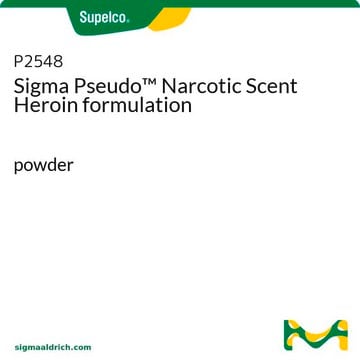H159
Heroin
analytical standard, ≥98% (HPLC)
Synonym(s):
Diacetylmorphine
About This Item
Recommended Products
grade
analytical standard
Quality Level
Assay
≥98% (HPLC)
form
powder
drug control
regulated under CDSA - not available from Sigma-Aldrich Canada; estupefaciente (Spain); Decreto Lei 15/93: Tabela IA (Portugal)
storage condition
desiccated
technique(s)
HPLC: suitable
gas chromatography (GC): suitable
color
white to beige
solubility
H2O: <0.2 mg/mL
DMSO: 5 mg/mL, clear
ethanol: 6 mg/mL
0.1 M HCl: <6.67 mg/mL
application(s)
forensics and toxicology
pharmaceutical (small molecule)
veterinary
format
neat
SMILES string
CN1CC[C@]23[C@H]4Oc5c(OC(C)=O)ccc(C[C@@H]1[C@@H]2C=C[C@@H]4OC(C)=O)c35
InChI
1S/C21H23NO5/c1-11(23)25-16-6-4-13-10-15-14-5-7-17(26-12(2)24)20-21(14,8-9-22(15)3)18(13)19(16)27-20/h4-7,14-15,17,20H,8-10H2,1-3H3/t14-,15+,17-,20-,21-/m0/s1
InChI key
GVGLGOZIDCSQPN-PVHGPHFFSA-N
Related Categories
General description
Application
Signal Word
Danger
Hazard Statements
Precautionary Statements
Hazard Classifications
Acute Tox. 2 Dermal - Acute Tox. 2 Inhalation - Acute Tox. 2 Oral
Storage Class Code
6.1A - Combustible, acute toxic Cat. 1 and 2 / very toxic hazardous materials
WGK
WGK 3
Flash Point(F)
Not applicable
Flash Point(C)
Not applicable
Personal Protective Equipment
Choose from one of the most recent versions:
Certificates of Analysis (COA)
Don't see the Right Version?
If you require a particular version, you can look up a specific certificate by the Lot or Batch number.
Already Own This Product?
Find documentation for the products that you have recently purchased in the Document Library.
Protocols
Analytical standards for drug analysis including heroin, cocaine, amphetamine, and methylenedioxymethamphetamine.
Analytical standards for drug analysis including heroin, cocaine, amphetamine, and methylenedioxymethamphetamine.
Analytical standards for drug analysis including heroin, cocaine, amphetamine, and methylenedioxymethamphetamine.
Analytical standards for drug analysis including heroin, cocaine, amphetamine, and methylenedioxymethamphetamine.
Our team of scientists has experience in all areas of research including Life Science, Material Science, Chemical Synthesis, Chromatography, Analytical and many others.
Contact Technical Service






